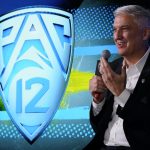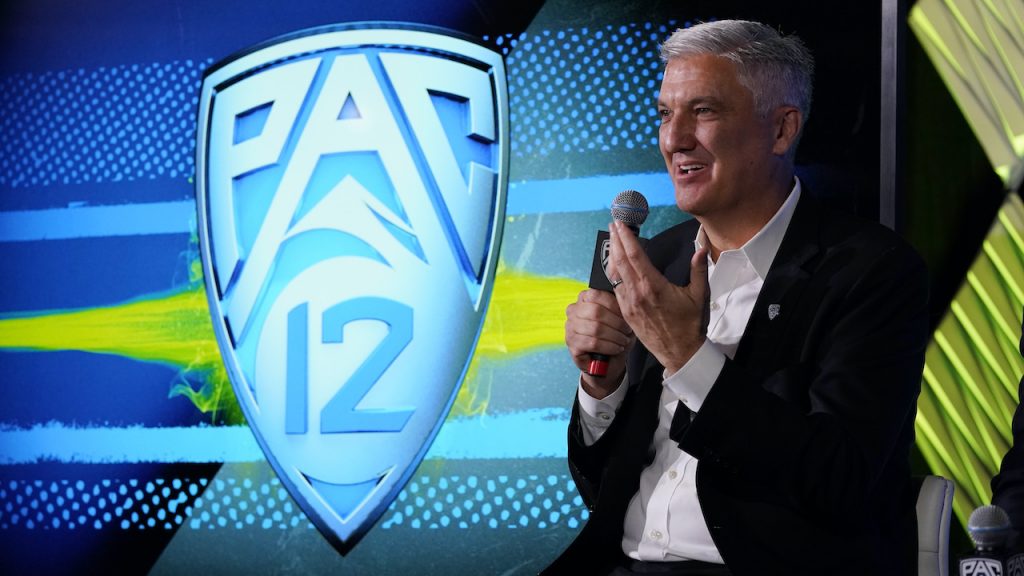Pac-12 commissioner George Kliavkoff presented a media rights contract to the schools on Tuesday, with nothing less than the future of the century-old conference at stake.
Details are sparse as the presidents and athletic directors digest the proposal, save for an ESPN report indicating Kliavkoff’s plan featured a heavy presence on Apple and a revenue structure that tied cash to subscriptions.
Our reaction …
1. Any chance to link arms with the richest, most influential, most innovative, savviest, smartest company in the world is something the Pac-12 should seriously consider, especially when that company is rapidly expanding its portfolio of sports properties and positioned to dominate the sports media landscape in the near future. But in this case, the details mean everything.
2. The lean into streaming comes as no surprise. Kliavkoff signaled his strategy 18 months ago, telling a sports media podcast: “Whatever deal we do, it’s my goal to have our content available on any piece of glass connected to the internet. Period, full stop.”
Six months later, at a Pac-12 football media event prior to the 2022 season, he indicated the conference’s next media rights deal was “highly likely” to feature a major digital media company.
Since that moment, we have presumed Apple or Amazon would have a significant role in the contract.
3. At the same time, the Hotline viewed any media rights deal that didn’t include a package of games on ESPN as a suboptimal approach.
ESPN is vital because of the product visibility provided by linear television and the network’s messaging power within the college sports space.
If the Pac-12 isn’t contractually tied to ESPN, then its highly-influential studio shows have little motivation to discuss the conference and promote its teams and players.
4. Which brings us to a critical point in this assessment: The unknown elements of the deal Kliavkoff presented.
Is the proposed contract only with Apple? Or is there a separate linear TV component? Did Apple commit to sub-licensing games on ESPN or another network? What other deals are under consideration, if any?
5. Within the Apple piece alone, there are myriad unknowns.
How much revenue is guaranteed per year? How easily reached are any subscription-based incentives? How would Pac-12 content be viewed on Apple products and, of course, what’s the cost?
Lacking details, we’ll presume the proposal loosely mirrors Major League Soccer’s new distribution deal with Apple: The MLS Season Pass was made available for $99 annually through the Apple TV app on iPhones, iPads, Macs, smart TVs, etc. (Existing subscribers received a discount.)
6. Another question: To what extent will Apple throw its immense marketing power behind the Pac-12?
“They have ways to engage people beyond what the other outlets do,” said a media industry source familiar with Apple’s work with the MLS. But is Apple fully committed to helping the Pac-12 thrive? What are the contractual stipulations in that regard?
7. How would the football schedule work, particularly the kickoff times?
Traditional broadcast windows do not exist on streaming platforms. Would there be a weekly selection process, or could the Pac-12 set the start times weeks (and perhaps months) in advance?
Would there be a need for Thursday or Friday games? Could each team play every home game at 1 p.m. or 4 p.m. if so desired?
8. How would an Apple deal impact recruiting?
Yes, the prospects want to perform on the sport’s biggest stages — that’s one reason the Hotline has always viewed ESPN as a critical piece to any contract.
That said, recruiting is increasingly driven by NIL opportunities, which aren’t connected to ESPN, and the transfer portal, where prospects seeking a second chance prioritize playing time and skill development.
Also, every high school recruit spends hours per day staring at his iPhone.
Which brings us back to the aforementioned question: To what extent will Apple throw its immense marketing power behind the Pac-12?
9. The conference plans to expand — it needs a 10th team in time for the 2024 football season. Will the targets change with a media contract that connects revenue to streaming subscriptions?
If the size of the fan base matters more than the size of the media market, perhaps San Diego State (undergraduate enrollment: approximately 31,000) is more advantageous than SMU (7,000).
Perhaps the conference would reconsider the merits of large schools with passionate followings, like Fresno State and Boise State, that have not been on the expansion radar.
Add this item to the lengthy list of unknowns.
10. Kliavkoff’s strategy also focused on limiting the duration of the contract. Specifically, he wanted a deal that expired before the new Big Ten (2030) and Big 12 (2031) contracts, thus giving the Pac-12 a chance to gorge at the media cash trough before its competition.
Within that approach is a vital calculation for the university presidents to consider: The next contract.
Yep, the schools are already (and smartly) thinking about what comes next. How would a contract cycle that begins in the summer of 2024 position the Pac-12 for a deal that starts in the summer of 2029?
This topic carries the most intrigue but is also the most difficult for us to parse, because we don’t know how the sports media landscape will look in five or six years.
But we know cord-cutting is real and that media companies are increasingly moving their sports inventory to streaming.
We know ESPN will become available on a direct-to-consumer basis in a few years, the company is seeking a strategic partner and Apple is a prime candidate for that role.
What might that mean for the Pac-12 in Year One of an agreement with Apple, and what would it mean for Years Three and Five?
Should the Pac-12 prioritize a close relationship with Apple above all else, including revenue?
Is the best comparison not the MLS Season Pass on Apple TV+ but, rather, the Big East’s marriage to ESPN in the early 1980s, when the network was on the verge of domination?
We cannot offer answers, but those are strategic issues the Pac-12 schools should consider.
Ultimately, there are too many unknowns — from the linear piece to the subscription incentives to the marketing plan — for the Hotline to render final judgment.
This much is clear: The future of the conference is at stake. Colorado just left for the Big 12, and Arizona could very well be next. That might force Arizona State to leave, sparking the swift extinction of the Pac-12 as we know it.
Is the Apple deal good enough to save it? The devil’s in the details.
*** Send suggestions, comments and tips (confidentiality guaranteed) to pac12hotline@bayareanewsgroup.com or call 408-920-5716
*** Follow me on Twitter: @WilnerHotline
*** Pac-12 Hotline is not endorsed or sponsored by the Pac-12 Conference, and the views expressed herein do not necessarily reflect the views of the Conference.
Related posts:

(AP Photo/Ralph Freso, File)
Wilner Hotline – Pac-12 survival guide: The strategic merits of an alliance (or merger) with the Big 12
(AP Photo/Ralph Freso, File)
Wilner Hotline – Presidential Power Index: Which Pac-12 presidents have the greatest influence over the conference’s future
(AP Photo/Marcio Jose Sanchez)
Wilner Hotline – The Pac-12’s survival depends on the Big Ten, not the Big 12: Tracing the path to stability
Southern California guard JuJu Watkins,(AP Photo/Mark J. Terrill)
Pac-12 WBB Preview – UCLA vs USC at the top, tough competition and rivalriesJon Wilner
Jon Wilner has been covering college sports for decades and is an AP top-25 football and basketball voter as well as a Heisman Trophy voter. He was named Beat Writer of the Year in 2013 by the Football Writers Association of America for his coverage of the Pac-12, won first place for feature writing in 2016 in the Associated Press Sports Editors writing contest and is a five-time APSE honoree.
